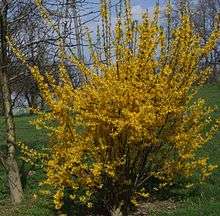''Forsythia'' × ''intermedia''
| Forsythia × intermedia | |
|---|---|
 | |
| Genus | Forsythia |
| Hybrid parentage | F.viridissima. × F. suspensa var. fortunei. |
| Cultivar | Forsythia × intermedia |
| Origin | Göttingen Botanic Gardens, Germany, 1878 |
Forsythia × intermedia, or border forsythia[1] is an ornamental deciduous shrub of garden origin.
Description
The shrub has an upright habit with arching branches and grows to 3 to 4 metres high.[2] The opposite leaves turn yellowish or occasionally purplish in the autumn before falling.[3] The bright yellow flowers are produced on one- to two-year-old growth and may be solitary or in racemes from 2 to 6.[2]
Origin
The hybrid is thought to be a cross between Forsythia viridissima and F. suspensa var. fortunei.[4] A plant of seedling origin was discovered growing in the Göttingen Botanical Garden in Germany by the director of the forestry botanical garden of the Royal Prussian Academy of Forestry in Münden, H. Zabel in 1878.[4] Zabel formally described and named the hybrid in Gartenflora in 1885.[5] It was introduced to the Arnold Arboretum in the United States in 1889.[4]
Cultivation
The hybrid is best suited to a position with full sun or partial shade and is drought-tolerant.[3] Like some other forsythia's it is one of, or even, the earliest shrub to bloom in humid continental climate, well adapted to temperature changes, blooms with bright yellow flowers, that are noticeable even in twilight. This makes forsythias widely cultivated in gardens, parks and various green parts of European towns, with Forsythia x intermedia hybrid being the most popular among forsythias.
Cultivars include (those marked agm have gained the Royal Horticultural Society’s Award of Garden Merit):-[6]
- 'Arnold Dwarf' - low-growing with pale yellow flowers[3]
- 'Beatrix Farrand' - a particularly floriferous cultivar[3]
- ’Courtalyn’agm[7]
- 'Gold Tide' ('Courtasol') - floriferous, with deep yellow autumn colour[3]
- 'Lynwood' - large flowers with broad petals[2]
- ’Lynwood Variety’agm[8]
- 'Karl Sax' - deep yellow flowers with orange lines in the throat. Introduced by the Arnold Arboretum in 1960.[2]
- 'Spectabilis'[2]
- 'Spring Glory' - purple-tinged foliage in autumn[3]
- 'Variegata' - leaves with contrasting cream edges[3]
Pinoresinol biosynthesis
The first dirigent protein was discovered in Forsythia intermedia. This protein has been found to direct the stereoselective biosynthesis of (+)-pinoresinol from coniferyl alcohol monomers.[9]
-Pinoresinol_Biosynthesis.svg.png)
References
- ↑ name=Dirr>Dirr, Michael A. (1997). Dirr's Hardy Trees and Shrubs - An Illustrated Encyclopedia. Timber Press. p. 58. ISBN 0-88192-404-0. Retrieved 2009-06-02.
- 1 2 3 4 5 Rowell, Raymond J. (1980). Ornamental Flowering Trees in Australia. Australia: AH & AW Reed Pty Ltd. ISBN 0-589-50178-X.
- 1 2 3 4 5 6 7 "Forsythia x intermedia". Plant fact sheets. NC State University. Retrieved 2009-06-01.
- 1 2 3 "Forsythia x intermedia". INRA Centre d'Angers. Retrieved 2009-06-02.
- ↑ "Forsythia ×intermedia". Germplasm Resources Information Network (GRIN). Agricultural Research Service (ARS), United States Department of Agriculture (USDA). Retrieved 2009-06-02.
- ↑ "AGM Plants - Ornamental" (PDF). Royal Horticultural Society. July 2017. p. 32. Retrieved 24 January 2018.
- ↑ "RHS Plantfinder - Forsythia × intermedia 'Courtalyn'". Retrieved 27 February 2018.
- ↑ "RHS Plantfinder - Forsythia × intermedia 'Lynwood Variety'". Retrieved 27 February 2018.
- ↑ Davin LB, Wang HB, Crowell AL, et al. (1997). "Stereoselective bimolecular phenoxy radical coupling by an auxiliary (dirigent) protein without an active center". Science. 275 (5298): 362–6. doi:10.1126/science.275.5298.362. PMID 8994027.
| Wikimedia Commons has media related to Forsythia × intermedia. |